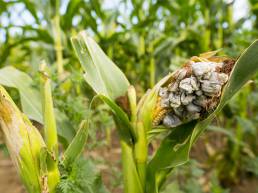In February 2014, the EFSA published an article on the use of formaldehyde in animal feed. When formaldehyde is used in animal feed, there is no increased intake of formaldehyde by the consumer. Therefore, the EFSA does not expect an increase in risk when formaldehyde is used.
Formaldehyde is an important metabolic intermediate product which is present in the body. It is important for the immune system in the protection against endogenous molecules. Because of this, formaldehyde can be used to control e.g. Salmonella in feed.
Formaldehyde is a water soluble liquid, which is oxidised to formic acid in the body. It is present in several animal products. The concentration in milk is 0,1-0,3 mg/kg and some fish species contain 200 mg/kg.
Interested in the complete article? Please contact us at: info@efs-holland.nl.
You may also like
Corn smut in maize silage and its threat to animal health
August 26, 2018
At the moment a lot of corn smut (field fungus) is found in maize fields as a result of prolonged drought, sometimes combined with sprinkler irrigation this growing season (2018).
Formaldehyde and Bact-Aid™
May 5, 2018
As the end of an era for formaldehyde becomes imminent, the need to find a good alternative to formaldehyde to control undesirable pathogens in raw materials and feeds, has become even more pressing.
Should we worry about mycotoxins in dairy feed?
May 23, 2011
Cows are capable of detoxifying limited amounts of mycotoxins in the rumen. This is on condition that the cow's rumen works properly. However, some mycotoxins have a very negative impact on the rumen flora which…






